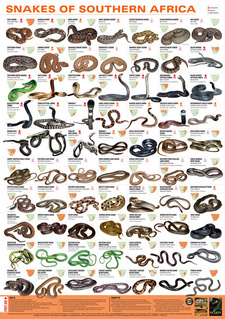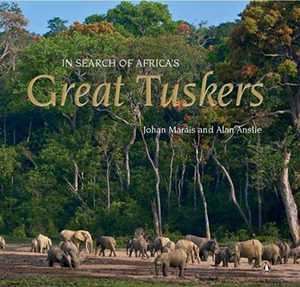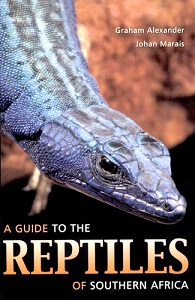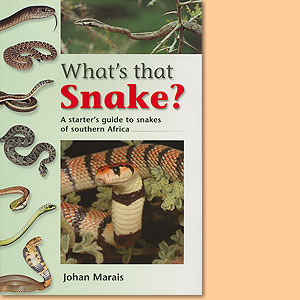Snakes & snakebite in Southern Africa, by Johan Marais

Snakes & snakebite in Southern Africa, by Johan Marais. Random House Struik-Nature. Cape Town, South Africa 2014. ISBN 9781775840237 / ISBN 978-1-77584-023-7.

This is an excerpt from the well known guide to Snakes & snakebite in Southern Africa (ISBN 9781775840237 / ISBN 978-1-77584-023-7).

Overview of snakes you might encounter in Southern Africa. From Johan Marais's guide Snakes & snakebite in Southern Africa.
How to use this book: This guide to snakes and snakebite in Southern Africa is intended as a practical tool to the easy identification of all the region's dangerous and common harmless snakes.
Its other important purpose is to provide quick and practical advice on first-aid measures, should someone get bitten. Within the accounts that follow, each species is introduced by its English common name, followed by its scientific name and an indication as to whether the snake is harmless, mildly venomous, dangerous or very dangerous. A separate 'Look out for' column highlights each snake's most prominent features, be that body markings, diagnostic signs or behaviour. This assists in easily identifying a specific snake species. Colour photographs have been used unsparingly, especially where several colour forms exist or where snakes differ in colour according to region. Photographs of similar or easily confused species are also featured along with the snake under discussion to rule out confusion between species. While every effort has been made to avoid technical language, some technical terms have been necessary; these are explained in the Glossary, which appears on page 86. The 42 snakes featured in this book have been grouped according to four snake types: the adders (pages 14-25); the elapids (pages 26-47), the back-fanged snakes (pages 48-67), and the fangless and non-poisonous snakes. Alternative English common names and the Afrikaans name(s), appear at the top of the left-hand column, and simple icons convey additional information about the snake:
- average size - shown relative to an average human male of 1,8 metres tall, or to an average human arm
- whether the snake lives mostly in trees, in shrubs, on the ground, or any combination of the three
- whether the snake is active during the day (diurnal], at night (nocturnal), or both.
Example: Western Barred Spitting Cobra
Naja nigricollis nigricincta
VERY DANGEROUS
Other names: Zebra Snake (E); Sebraslang (A) t
Average 1,0 m
Maximum 1,5 m
LOOK OUT FOR:
Distinct black rings or crossbars on the body and tail.
Often found on tarred roads.
Active at night, especially after rain.
Preferred habitat: The Namib Desert and Karoo regions of central and northern Namibia, extending into the southern reaches of Angola.
Habits: A nocturnal snake that is often found on tarred roads. It is shy choosing to escape if it has the choice, but if cornered will spread a hood and may spit its venom.
Similar species: May be confused with the harmless Tiger Snake and the Coral Snake.
Enemies: Predatory birds and snakes. Vehicles on tarred roads kill many individuals.
Food and feeding: Feeds on other snakes, lizards, toads and small mammals.
Reproduction: Oviparous, laying 10-22 eggs.
Danger to man: Common where it occurs, and accounting for many bites among humans. This snake's venom is dangerously cytotoxic. This snake spits readily and effectively but is not confrontational and usually chooses to escape.
Venom: A potent cytotoxic venom which may cause severe tissue damage. It bites and also spits venom. For treatment of venom in the eyes, see 'Spitting Snakes' on page 10.
First-aid procedures:
- Immobilise and reassure the patient, who must lie down and be kept as quiet as possible
- Apply a pressure bandage immediately (see page 9) and immobilise the limb with a splint to reduce the spread of venom
- Loosen, but do not remove, the bandage if there is severe swelling
- Transport promptly to hospital
This is an extract from: Snakes and Snakebite in Southern Africa
Title: Snakes and Snakebite in Southern Africa
Author: Johan Marais
Publisher: Random House Struik
Imprint: Nature
Cape Town, South Africa 2014
ISBN 9781775840237 / ISBN 978-1-77584-023-7
Paperback, 15 x 21 cm, 120 pages, throughout colour photos
Marais, Johan im Namibiana-Buchangebot
Snakes & snakebite in Southern Africa
This guide is an uncomplicated approach to snakes and snakebites in Southern Africa, the emphasis is on identification, and on first aid treatment of snakebites.
A Complete Guide to the Snakes of Southern Africa
A Complete Guide to the Snakes of Southern Africa: this is updated and expanded 3rd edition / 2022.
In search of Africa's Great Tuskers
In Search of Africa's Great Tuskers we travels to some of the most remote and beautiful African landscapes to meet the legendary 'hundred-pounders' bull elephants.
What's that Reptile? A starter's guide to reptils of southern Africa
What’s that? series introduces starters to the diverse reptile fauna of southern Africa, including its snakes, lizards, crocodiles, tortoises, terrapins and turtles.
A Guide to the Reptiles of Southern Africa
A Guide to the Reptiles of Southern Africa introduces the 517 species currently described in the region, arranged into three main groups - snakes and lizards, crocodiles, and shelled reptiles.
What’s that Snake? A starter’s guide to snakes of southern Africa
What’s that snake is a good starter’s guide to identification of most common snakes of southern Africa.
A Complete Guide to the Snakes of Southern Africa (2nd edtion 2004)
The complete guide covers all essential aspects of snake biology and behaviour to 151 snakes of southern Africa. This 2nd edtion 2004 is on special offer.







